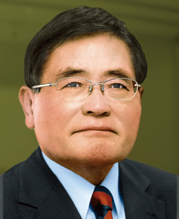Shizuka Kamei
Shizuka Kamei | |
|---|---|
亀井 靜香 | |
 Official Portrait | |
| Minister of State for Financial Services | |
| In office 16 September 2009 – 11 June 2010 | |
| Prime Minister | Yukio Hatoyama Naoto Kan |
| Preceded by | Kaoru Yosano |
| Succeeded by | Shōzaburō Jimi |
| Minister of Construction | |
| In office 7 November 1996 – 11 September 1997 | |
| Prime Minister | Ryutaro Hashimoto |
| Preceded by | Eiichi Nakao |
| Succeeded by | Tsutomu Kawara |
| Minister of Transport | |
| In office 30 June 1994 – 8 August 1995 | |
| Prime Minister | Tomiichi Murayama |
| Preceded by | Nobuaki Futami |
| Succeeded by | Takeo Hiranuma |
| Member of the House of Representatives | |
| In office 8 October 1979 – 28 September 2017 | |
| Succeeded by | Koji Satō |
| Constituency | Hiroshima-6th (1996–2017) Hiroshima-3rd (1979–1996) |
| Minister for Postal Reform | |
| In office September 16, 2009 – June 8, 2010 | |
| Personal details | |
| Born | 1 November 1936 Shōbara, Hiroshima, Japan |
| Political party | Independent (2014–2017) |
| Other political affiliations |
|
| Children | 5 |
| Alma mater | University of Tokyo |
| Website | Official website |
Shizuka Kamei (亀井 静香, Kamei Shizuka, born 1 November 1936) is a former Japanese politician and a former chairman of the Parliamentary League for the Abolition of the Death Penalty.[1][2][3]
Early life[edit]
He was born in the city of Shōbara in Hiroshima Prefecture into a poor family. He studied at the department of economics at University of Tokyo and worked his way through school through various jobs, including singing at a cabaret.
Upon graduation in 1960, he entered Sumitomo Seika, and joined the National Police Agency in 1962. In 1972, he took charge of a number of high-profile cases, including the Red Army Asama-Sanso incident, the Narita Airport incident, and the Tel Aviv highjacking. Kamei is one of the few major politicians to oppose the death penalty, and wrote a book, Shikei Haishi ron, asserting his opposition.
Political career[edit]
In 1977, he left the agency and received 3.5 million yen in severance pay, which he used to run for the Diet in Hiroshima. He was elected in 1979 as a member of the Liberal Democratic Party (LDP).
In 1989, he formed the Freedom Reform Alliance, criticizing the LDP's system of factions and strongly supported Shintarō Ishihara. He became Minister of Transport in 1994 and Minister of Construction in 1996. In 1998, he left the Mitsuzuka faction and formed the "Nakayama-Kamei group" with Minister of Foreign Affairs Taro Nakayama.
In 1999, he headed up the LDP's Policy Research Council and founded the Kamei faction. In 2003, he unsuccessfully ran for the position of Prime Minister against the incumbent, Junichiro Koizumi.
He opposed Koizumi's postal privatization plan and left the LDP in 2005, forming the Kokumin Shinto (People's New Party) with four other Diet members. Despite facing the popular businessman Takafumi Horie in the 2005 election, he won reelection for the tenth time.
On 16 September 2009, Kamei became the banking and postal services minister in the newly formed Hatoyama cabinet. Throughout the week, he voiced his commitment to providing economic stability for small companies, who he claimed "had lost vitality".[4] He plans to provide a moratorium of up to three years on loan repayments and attempts to put a brake on what he perceives as excesses by financial and lending institutions.[5]
Kamei decided not to run in the 2017 Japanese general election and therefore lost his seat in the House of Representatives.[6]
Cultural references[edit]
He is sometimes humorously referred to as Shizuka-chan (where "chan" is a title usually reserved for young girls) after a female character in the manga Doraemon who shares his personal name.
The character "Takeo Tsuruta" in the manga Akumetsu is based on him.
Scandal[edit]
In August 2003, Kamei acknowledged receiving political donations from the leader of a group of loan sharks affiliated to the Yamaguchi-gumi, the largest known yakuza syndicate in Japan.[7] The donor was Susumu Kajiyama.[8]
Personal life[edit]
Kamei is a six-level blackbelt in Aikido and enjoys golf and oil painting. His niece Akiko is a current member of the House of Representatives.
See also[edit]
References[edit]
- ^ Shizuka Kamei: “Abolition of the Capital Punishment System”.
YouTube.
FCCJchannel (YouTube channel).
Published 6 October 2016.
Retrieved 15 December 2016. - ^ The Capital Punishment Debate in Japan. Nippon.com. Published 16 April 2015. Retrieved 13 November 2018.
- ^ The Death Penalty in Japan: The Law of Silence. International Federation for Human Rights. Retrieved 13 November 2018.
- ^ Japan Bank Min Kamei:Moratorium Must Be Discussed In Best Way Nasdaq.com, September 17, 2009.
- ^ 新政権で金融株激震 亀井など閣僚発言が波乱要因[permanent dead link] Yahoo! Japan, September 18, 2009.
- ^ 応援して下さった皆様へ. Shizuka-Kamei official website. Retrieved 13 November 2018.
- ^ "Out of the shadows", August 19, 2003, The Independent
- ^ (in Japanese)"Shizuka Kamei, political donations from the loan shark king, Susumu Kajiyama" Archived 2012-03-26 at the Wayback Machine, August 15, 2003, Rondan or "Goryo-kai senior who was arrested for underground loaning - donations to Shizuka Kamei", August 17, 2003, Shimbun Akahata
Further reading[edit]
- Shikei Haishi Ron (死刑廃止論), Shizuka Kamei, Publisher kadensha (花伝社) ISBN 4-7634-0389-3, July 2002.
External links[edit]
- 1936 births
- Living people
- Japanese anti–death penalty activists
- Japanese police officers
- Liberal Democratic Party (Japan) politicians
- Members of the House of Representatives (Japan)
- Ministers of Construction of Japan
- Ministers of Transport of Japan
- People from Hiroshima Prefecture
- People's New Party politicians
- Tomorrow Party of Japan politicians
- University of Tokyo alumni
- 21st-century Japanese politicians
- Japanese aikidoka
- People from Shōbara
- Politicians from Hiroshima Prefecture
